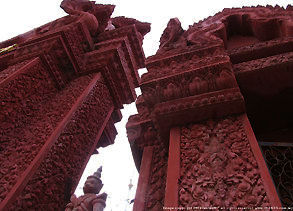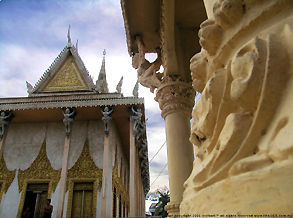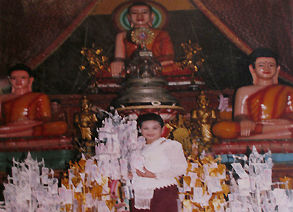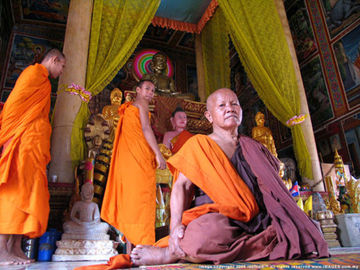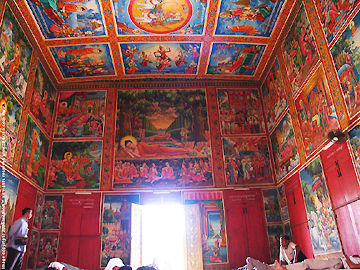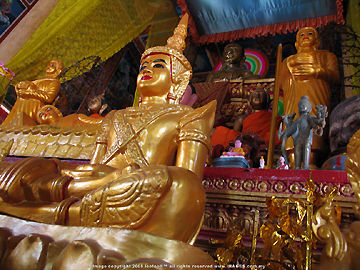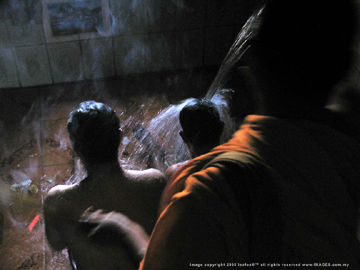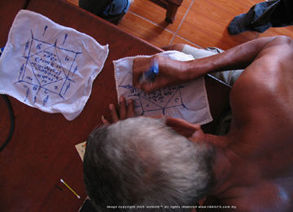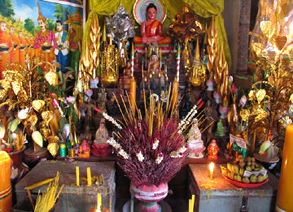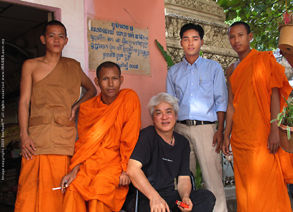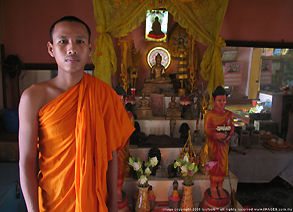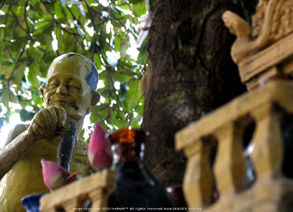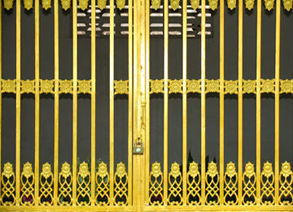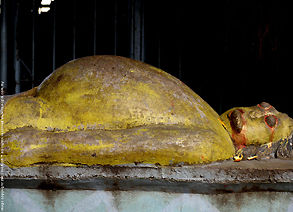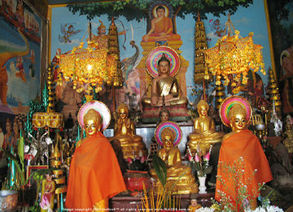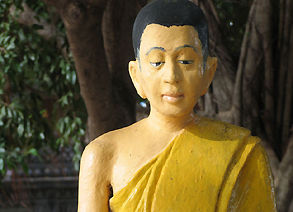|
|
Sraa Chak Pagoda (Wat Srash Chok)
Phnom Penh, Kingdom of Cambodia
Location Map:- .
| Click on Calmet Hospital Link from Image Map |
Merely few hundred yards away from the road (Maot Chrouk Road) opposite Phnom Penh Hotel & Calmet Hospital (not too far from the British and French Embassies)
I cannot find any reference of how many Cambodian temples are there in this Buddhist majority Nation. I was told, Wat Ounalom is the country's Buddhist Supreme Patriarch but never had the chance to ask or check. Anyway, other than the much publicize Wat Phnom that I had created the site earlier, there are quite a number of others, which includes Phnom Penh’s five original monasteries (1422) like Wat Botum, Wat Langka, Wat Koh etc. However, I am more incline to talk a look at the "ordinary" or typical - ones that most public goes rather than tourists. Across the Phnom Penh Hotel where I was staying during this trip; there are actually a few Cambodian temples, one of which that I returned and took a full afternoon to get a real feel of Cambodian culture as it was coincidentally a Buddhist celebrity day for the locals.
Generally, temples in Cambodian are generally named individually as "Wat" or Pagodas. They can be several structures are encompassed or when a famous figure had his ashes housed in a Stupa or Chedi, the name could override the name of the Wat by using the Pagoda. In any case, every typical temple will has a central ornate sanctuary (Thai may refer it as Viham, here it sounds like Vihara or Vihearm - for an example, the photo at the top of this page is the center stage of the Sraa Chak Pagoda). Most raw Cambodian temples for locals has a lesser influence of Indian flavor - even if they are termed as Khmer Temples. Popular statues like Naga, dvarapala, chinthe are not installed everywhere like the Angkor Wat kind of design. But one way or another, usually the entrance arc and pillars still retained the ancient feel and look. Similarly, the apparent feel of typical ancient Khmer architecture was at its entrance, although inside, the use of such design are lesser in numbers. Unlike other popular tourist Buddhist landmarks or destinations, admission into one of these local temples is free, even for foreigners. The few young monks that I met and a young, handsome man, Pheach Pheara who mixed with them was incredibly friendly. They voluntarily escort and show me around the entire premises, answered many questions and even lead to me to meet the Chief of this temple, Chean Sothy where I had my first blessing via a Cambodian way.
According to the chief monk, Chean Sothy, Wat (Sraa Chak Pagoda) is not as good as the 633 years old (as t 2005) Wat Phnom but it has a few hundred years old history as well. The current state of the temple was a result of a sequence of reconstruction processes, the last phase of restoration and construction of the main hall occurred 15 years ago i.e. 1990-1992. The wat is made up of several structures with the Vihearm located at the center, at the front and behind hide a Pagoda and a few Chedi of smaller scales. The left and right smaller units of residence could have been handled and operated individually by senior ranking monks and each of them also had smaller installation Buddhist images; each locations can accept or attend to public on request for blessing or other affairs Naturally, the Chao-a-Wat place of work or rest is located next to the Vihearm. The rest of other monks of junior ranking stay at the rear section where it was prohibited for entry. At the front, a few small Stupas which was decorated by a few statues depicting life and death cycles. I would think most of others could be following this model of arrangement of various structures and design. However, some well established Wat / Temples in Cambodia also operate Schools for the poor as well as permitting the homeless to temporarily seeking for shelter at day or night, the one issue is, some of them are making use of the main hall instead of the side structures - so, it may presents a little strange and uneasy feelings when you notice there are people sleeping at the center stage. I was told they are not permitted to do so, but there are some uncontrolled disciplinary issue to deal with the homeless intruders.
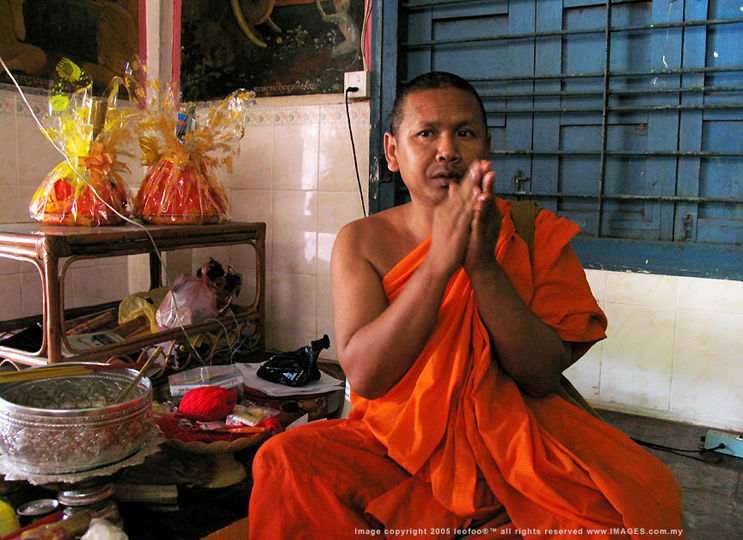
Like the Thai and Burmese, Cambodian also practices traditional way is requiring the male entering monk hood at least few months in their life to learn native Buddhist codes in morale values, philosophy thinking as well as practice Buddhist form of chanting. The few young monks I met were memorizing and chanting a loud while I was there. One way or another, various Buddhist temples also serve as a learning centre for education for the poor and unaffordables. Some Wats even have courses to teach medical studies on local herbs and provides basic training for administrative organization and/or temple management.
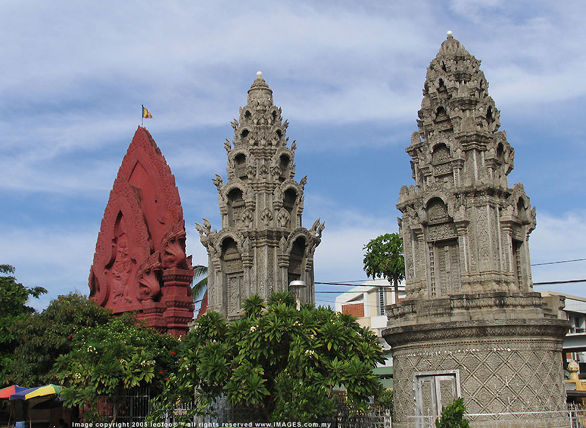 |
| Back |
|


